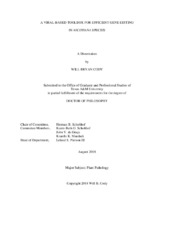| dc.description.abstract | The CRISPR/Cas9 site-specific nuclease from a prokaryotic viral defense mechanism has been adapted into a gene editing tool for molecular biologists. Consisting of two deliverable parts, a Cas9 nuclease and sequence specific single guide RNA (sgRNA), CRISPR/Cas9 simplicity of design is its hallmark feature. While the system has brought gene editing to virtually every laboratory bench, there remain many aspects of the system not yet explored.
Here, I have combined the overexpression capabilities of a plant viral vector, along with CRISPR technology, for efficient targeted gene mutagenesis of a plant host. Through delivery of sgRNAs with a viral vector I have addressed two issues currently hindering gene editing in plant biology: low efficiency associated with current delivery infrastructure and the reliance on transgenic integration of gene editing parts. The results in Nicotiana benthamiana plants demonstrate the novel delivery of sgRNAs with substantial 5′ upstream and 3′ downstream RNA sequences yields efficient editing in vivo, which previously was considered to not produce catalytically active complexes. In addition to viral vector-based gene editing, I also rationally designed a subgenomic RNA where viral-based protein overexpression remains intact while simultaneously delivering sgRNAs.
Following these results, I looked to explore DNA double stranded breaks (DSB) capabilities of Cas9 with transcripts carrying 5′ and 3′ sgRNA “overhang” sequences. In vitro experiments demonstrated that 5′ sgRNA overhangs inactivate the catalytic activity of Cas9/sgRNA complexes, which hints that a native 5′ RNA processing mechanism in N. benthamiana must be present for viral delivery of biologically competent sgRNAs. Furthermore, 5′ sgRNA processed products were verified from viral delivered sgRNAs, in planta, and further
exploration revealed that processing events localized to the cytosol. A contemporary model is proposed for the processing events with specific host pathways implicated.
Lastly, I focused on the application of protein and sgRNA co-delivery using a viral vector for imaging of virus replication and movement while inactivating host genes. A survey revealed that the application of this system in diverse Nicotiana species is feasible. This is a potentially pivotal tool to further our understanding of plant-virus interactions. | en |


